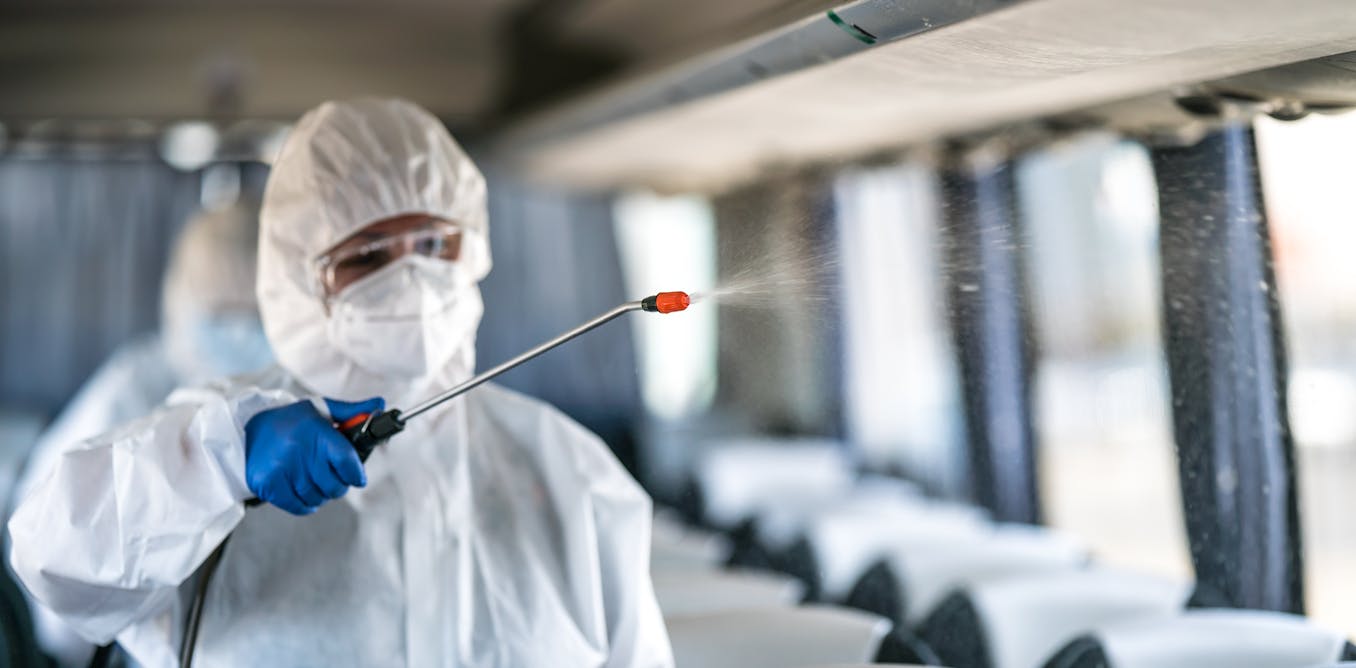When the COVID pandemic hit, many people turned to the eerily prescient film Contagion (2011) for answers – or at least for catharsis. Suddenly, its hypothetical plot felt all too real. Applauded for its scientific accuracy, the film offered more than suspense – it offered lessons.
One scene in particular stands out. Kate Winslet’s character delivers a concise lesson on the infectious power of various pathogens – explaining how they can be spread from our hands to the many objects we encounter each day – “door knobs, water fountains, elevator buttons and each other”. These everyday objects, known as fomites, can become silent vehicles for infection.
She also considered how each infection is given a value called R0 (or R-nought) based on how many other people are likely to become infected from another. So, for an R0 of two, each infected patient will spread the disease to two others. Who will collectively then give it to four more. And so a breakout unfolds.
The R0 measure indicates how an infection will spread in a population. If it’s greater than one (as seen above), the outcome is disease spread. An R0 of one means the level of people being infected will remain stable, and if it’s less than one, the disease will often die out with time.
Circulating infections spread through a variety of routes and differ widely in how contagious they are. Some are transmitted via droplets or aerosols – such as those released through coughing or sneezing – while others spread through blood, insects (like ticks and mosquitoes), or contaminated food and water.
But if we step back to think about how we can protect ourselves from developing an infectious disease, one important lesson is in understanding how they spread. And as we’ll see, it’s also a lesson in protecting others, not just ourselves. Here is a rundown of some of the most and least infectious diseases on the planet.
In first place for most contagious is measles.
Measles has made a resurgence globally in recent years, including in high-income countries like the UK and US. While several factors contribute to this trend, the primary cause is a decline in childhood vaccination rates. This drop has been driven by disruptions such as the COVID pandemic and global conflict, as well as the spread of misinformation about vaccine safety.
The R0 number for measles is between 12 and 18. If you do the maths, two cycles of transmission from that first infected person could lead to 342 people catching the illness. That’s a staggering number from just one patient – but luckily, the protective power of vaccination helps reduce the actual spread by lowering the number of people susceptible to infection.
Measles is extraordinarily virulent, spreading through tiny airborne particles released during coughing or sneezing. It doesn’t even require direct contact. It’s so infectious that an unvaccinated person can catch the virus just by entering a room where an infected person was present two hours earlier.
People can also be infectious and spread the virus before they develop symptoms or have any reason to isolate.
Other infectious diseases with high R0 values include pertussis, or whooping cough (12 to 17), chickenpox (ten to 12), and COVID, which varies by subtype but generally falls between eight and 12. While many patients recover fully from these conditions, they can still lead to serious complications, including pneumonia, seizures, meningitis, blindness, and, in some cases, death.
Low spread, high stakes
At the other end of the spectrum, a lower infectivity rate doesn’t mean a disease is any less dangerous.
Take tuberculosis (TB), for example, which has an R0 ranging from less than one up to four. This range varies depending on local factors like living conditions and the quality of available healthcare.
Caused by the bacterium] Mycobacterium tuberculosis, TB is also airborne but spreads more slowly, usually requiring prolonged close contact with someone with the active disease. Outbreaks tend to occur among people who share living spaces – such as families, households, and in shelters or prisons.
The real danger with TB lies in how difficult it is to treat. Once established, it requires a combination of four antibiotics taken over a minimum of six months. Standard antibiotics like penicillin are ineffective, and the infection can spread beyond the lungs to other parts of the body, including the brain, bones, liver and joints.
What’s more, cases of drug-resistant TB are on the rise, where the bacteria no longer respond to one or more of the antibiotics used in treatment.
Other diseases with lower infectivity include Ebola – which is highly fatal but spreads through close physical contact with bodily fluids. Its R0 ranges from 1.5 to 2.5.
Diseases with the lowest R0 values – below one – include Middle East respiratory syndrome (Mers), bird flu and leprosy. While these infections are less contagious, their severity and potential complications should not be underestimated.
The threat posed by any infectious disease depends not only on how it affects the body, but also on how easily it spreads. Preventative measures like immunisation play a vital role – not just in protecting people, but also in limiting transmission to those who cannot receive some vaccinations – such as infants, pregnant women and people with severe allergies or weakened immune systems. These individuals are also more vulnerable to infection in general.
This is where herd immunity becomes essential. By achieving widespread immunity within the population, we help protect people who are most susceptible.
Get your news from actual experts, straight to your inbox. Sign up to our daily newsletter to receive all The Conversation UK’s latest coverage of news and research, from politics and business to the arts and sciences.



